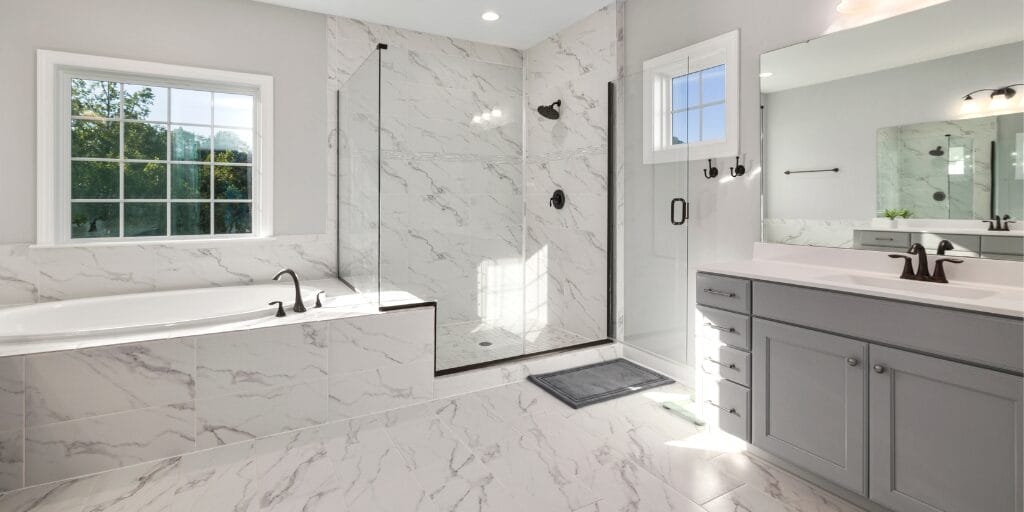Bathroom renovations are one of the most rewarding home improvement projects, but they can quickly turn into one of the most expensive and mistake-prone if not approached with the right knowledge. From budgeting blunders to material missteps, many homeowners fall into the same traps that end up costing more time, money, and headaches down the line.
Here’s a look at a few common bathroom renovation mistakes, and (more importantly), how you can avoid them!
Budget mistakes
We all know that a quality bathroom renovation isn’t cheap. A mid-range full renovation typically falls between £12,000 and £17,000, and while it might be tempting to shave a few thousand off the cost, cutting corners often backfires.
One of the most common shortcuts we see is tiling over old tiles. It might seem like a simple way to save on labour and materials, but the results are very rarely worth it. The new bathroom tiles often don’t sit flush, leading to a warped appearance or loose finishes. In some cases, the unevenness is visible immediately, forcing a full redo right away and leaving you paying more than you would have done to do it properly in the first place.
Another area where people try to save is skipping proper wall preparation. After removing old tiles, some homeowners choose not to re-plaster the wall, thinking the new tiles will hide the imperfections. But poorly prepped walls tend to result in uneven finishes and can even compromise waterproofing, leading to much bigger problems with damp later on.
How to avoid it:
- Plumbing, waterproofing, and plastering should never be skimped on.
- Always remove old tiles properly and prep surfaces from scratch.
- Cutting a £15,000 renovation to £13,000 by skipping important steps isn’t saving, it’s just setting you up future repairs and probably going to cost you much more in the long run.
Poor ventilation
We know, it’s not quite as fun and glamorous as choosing the perfect tiles or picking out stylish fixtures, but ventilation is an absolutely vital part of any bathroom design. Relying on an open window or an undersized extractor fan isn’t enough, especially in colder months when windows stay shut and moisture hangs around.
Without proper airflow, mould and mildew can quickly take hold, damaging finishes and compromising air quality. Worse still, the damage might not be visible until it’s already done harm beneath the surface.
How to avoid it:
- Install a powerful, properly sized extractor fan suited to the room’s square footage.
- Don’t assume windows are enough. Even if your bathroom has a window, a fan is still essential.
- Keep it on a timer or humidity sensor to run after you’ve left the room, ensuring all moisture is dealt with properly.
Material selection
Trendy materials might look great on Pinterest, but in the real world, your bathroom needs to stand up to daily wear, steam, and splashes. That ultra-modern concrete sink or non-waterproof wallpaper may look the part, but they often come with high maintenance or durability issues.
There’s also the issue of over-designing, where homeowners go all-in on a trendy look without thinking about the long term. Features like bold tile bands, flashy textures, or unusual colour palettes can feel outdated quickly or make a small room feel even smaller. Of course, it’s fine to do these things if that’s your style preference but just be wary of following trends purely because they’re trendy!
How to avoid it:
- Choose waterproof and easy-to-clean materials, especially for high-moisture areas.
- Stick to timeless foundations for walls and floors and add personality through accessories that are easier to change later.
- Use large tiles with minimal grout lines as they look great and are easier to maintain.
Overcrowding the space
It’s easy to get carried away when planning a new bathroom. But just because something fits on paper doesn’t mean it works in practice. One of the most common mistakes is trying to fit too much into a small space.
When every fixture is crammed together (especially in a standard UK bathroom), you lose that sense of openness. For example, squeezing in a large vanity may leave you with tight gaps between the toilet and shower, which affects both usability and aesthetics.
How to avoid it:
- Leave enough breathing room between fixtures. 60cm is standard, but even more is better.
- Choose wall-hung units or floating vanities to free up floor space and create a more open feel.
- Think both practically and visually. A smaller fixture might serve you better than a larger one that disrupts the flow.
Ignoring professional advice
When designing a bathroom, you need to think beyond the finishes and understand how the room works as a whole. One common mistake is going against professional advice or insisting on features that don’t suit the space.
For instance, placing a feature tile band vertically in a small room may seem like a bold design choice, but if it’s off-centre or doesn’t align with the bath or main wall, it can look jarring rather than stylish. Or opting for a traditional pedestal sink when a wall-hung option would make the room feel twice as big.
How to avoid it:
- Work with a bathroom professional who listens but also be open to their suggestions. A good installer or designer will balance your taste with what works best for the space.
- Prioritise the overall design rather than forcing a feature just for the sake of it.
- Remember, it’s not always about spending more, sometimes the better option costs the same or even less, it just needs careful planning.
Ready to skip the bathroom renovation mistakes and get your dream bathroom? Then contact our friendly team today! We have decades of experience in bathroom design and would love to help you create your ideal bathroom.

